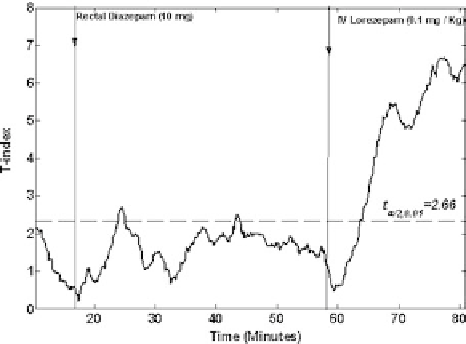Information Technology Reference
In-Depth Information
Fig. 17.2: AED resetting of brain dynamics in SE (Patient 1 - child). The average
T-index profile of all entrained pairs of electrode sites, selected prior to SE on-
set, over time (80 min scalp EEG record). The patient developed SE while he was
in the EMU at BNI undergoing presurgical evaluation. The patient was adminis-
tered diazepam rectally 24 min into the recording, and 0.1 mg/kg of lorezepam in-
travenously 61 min into the recording (times of AEDs administration are denoted by
the
vertical arrows
). Both drugs desynchronized the brain in the short term. How-
ever, the one administered intravenously had the maximum and most enduring ef-
fect on the desynchronization of the brain. The patient recovered by the end of this
record.
were selected for the estimation of the average T-index and followed over time.
For Patient 2, due to the discontinuity of the available EEG data, the STL
max
and
the T-index profiles were first estimated separately per available file using the ap-
proach given in Section 17.2; the results were then concatenated. Figure 17.2 shows
resetting of brain dynamics (from low to high T-index values) after a successful
administration of AEDs in Patient 1. Figure 17.3 illustrates a successful treatment
and resetting of the EEG dynamics by AEDs in Patient 2 over a considerably longer
period than the one in Patient 1.
During SE, and prior to the administration of the first AED, the average T-index
was lower than the statistical threshold of entrainment, suggesting that the corre-
sponding critical brain sites were entrained. Within minutes of the first AED treat-
ment (diazepam in the first patient and fosphenytoin in the second patient), signs
of disentrainment of the brain dynamics were observed in both patients. Within
10-20 min after the administration of the first AED, in both patients the brain be-
came entrained again (T-index reversed its route toward above the statistical thresh-
old of entrainment and started to assume lower values). The administration of sub-
sequent AED(s) (lorazepam in the first patient, fentanyl and propofol in the second
patient) dynamically disentrained the brain (statistically high T-index values were
attained and sustained). Both patients recovered. Once the patients progressed out

